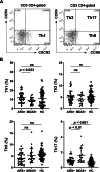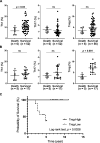Immune cell profiles of idiopathic inflammatory myopathy patients expressed anti-aminoacyl tRNA synthetase or anti-melanoma differentiation-associated gene 5 autoantibodies
- PMID: 37752437
- PMCID: PMC10523699
- DOI: 10.1186/s12865-023-00569-w
Immune cell profiles of idiopathic inflammatory myopathy patients expressed anti-aminoacyl tRNA synthetase or anti-melanoma differentiation-associated gene 5 autoantibodies
Abstract
Background: Patients with idiopathic inflammatory myopathy (IIM) often express a different type of myositis-specific autoantibodies (MSAs), each associated with different clinical symptoms. Understanding the immunopathogenesis of various IIM subgroups can help improve the diagnosis and prognosis of IIM patients with different MSAs. However, the immune cell profiles of these IIM patients with anti-aminoacyl tRNA synthetase (ARS) or anti-melanoma differentiation-associated gene 5 (MDA5) autoantibodies remain unclear. We focused on the immune cell profiles of IIM patients with anti-ARS or anti-MDA5 autoantibodies.
Results: The peripheral blood from IIM patients with anti-MDA5 autoantibody (MDA5 + group, n = 24) or one of the anti-ARS autoantibodies (ARS + group, n = 40) autoantibodies, and healthy controls (HC group, n = 60) were collected and examined. We found that IIM patients had a lower CD3 T cell population compared to the HC group. IIM patients showed a significantly lower TN cell population and a higher TEMRA cell population. Higher Th17 and Treg cell populations were found in these IIM patients than in the HC group. In these IIM patients, the MDA5 + group exhibited the higher percentages of Th17 and Treg cells than the ARS + group. It is noteworthy that the percentage of Th1 cells in the survival subgroup was higher than in the death subgroup in IIM patients with ARS + or MDA5 + . Furthermore, in the MDA5 + group, the percentage of Treg cells was higher in the survival subgroup compared to the death subgroup.
Conclusions: Our study demonstrated that elevated Th1 may be a good prognostic indicator in IIM patients with ARS + or MDA5 + . Elevated Treg may also help predict a good prognosis in MDA5 + IIM patients. However, more large-scale studies and clinical samples are needed to verify the significance of Th1 and Treg cell subsets in clinical outcomes for these IIM patients with ARS + or MDA5 + . These data may help design a therapeutic approach that specifically targets the pathogenic immune molecular responsible for autoimmune attacks in IIM.
Keywords: Aminoacyl-tRNA synthetase (ARS); Idiopathic inflammatory myositis (IIM); Immune cell profiles; Melanoma differentiation-associated gene 5 (MDA5); Myositis-specific autoantibody (MSA).
© 2023. The Author(s).
Conflict of interest statement
The authors declare no competing interests.
Figures





Similar articles
-
Long-term risks of malignancy in myositis-specific antibody-positive idiopathic inflammatory myopathy.Rheumatol Int. 2023 Feb;43(2):335-343. doi: 10.1007/s00296-022-05214-0. Epub 2022 Sep 29. Rheumatol Int. 2023. PMID: 36175662
-
Clinical features and prognosis of idiopathic inflammatory myopathies with coexistent multiple myositis-specific antibodies.Clin Exp Rheumatol. 2025 Feb;43(2):211-220. doi: 10.55563/clinexprheumatol/22j41g. Epub 2024 May 30. Clin Exp Rheumatol. 2025. PMID: 38819961
-
Age distribution and prevalence in different age groups of four myositis-specific autoantibodies, including anti-ARS, anti-MDA5, anti-Mi-2, and anti-TIF1γ antibodies.J Dermatol. 2023 Aug;50(8):1058-1062. doi: 10.1111/1346-8138.16772. Epub 2023 Mar 8. J Dermatol. 2023. PMID: 36890683
-
A Comprehensive Overview on Myositis-Specific Antibodies: New and Old Biomarkers in Idiopathic Inflammatory Myopathy.Clin Rev Allergy Immunol. 2017 Feb;52(1):1-19. doi: 10.1007/s12016-015-8510-y. Clin Rev Allergy Immunol. 2017. PMID: 26424665 Free PMC article. Review.
-
Idiopathic inflammatory myopathies and the anti-synthetase syndrome: a comprehensive review.Autoimmun Rev. 2014 Apr-May;13(4-5):367-71. doi: 10.1016/j.autrev.2014.01.022. Epub 2014 Jan 11. Autoimmun Rev. 2014. PMID: 24424190 Free PMC article. Review.
Cited by
-
Exosomes as key mediators in immune and cancer cell interactions: insights in melanoma progression and therapy.Arch Dermatol Res. 2025 Apr 19;317(1):729. doi: 10.1007/s00403-025-04237-4. Arch Dermatol Res. 2025. PMID: 40252131 Review.
References
-
- Cheeti A, Brent LH, Panginikkod S: Autoimmune Myopathies. In: StatPearls. edn. Treasure Island (FL): StatPearls Publishing Copyright © 2023, StatPearls Publishing LLC.; 2023. - PubMed
-
- Sarwar A, Dydyk AM, Jatwani S. Polymyositis. In: StatPearls. edn. Treasure Island (FL): StatPearls Publishing LLC; 2023. StatPearls Publishing Copyright © 2023. - PubMed
Publication types
MeSH terms
Substances
LinkOut - more resources
Full Text Sources
Medical

